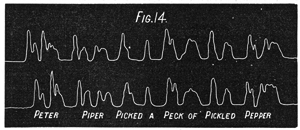 |
PaleospectrophonyNOTE: This initial account of methods for transducing images into sound—first posted in 2009—is maintained here for its historical interest. You can also find it archived in Archive.org's Wayback Machine. For current information, please visit griffonage.com. |
6. Telegrams and Logograms6.1—So far we've considered inscriptions that represent time along one axis and frequency along another axis (to one extent or another). But we can also use paleospectrophony to "play" any inscription that tracks the intensity of a parameter over time. To do this, we need to change our settings so that the output varies only in volume. The first step is to set the top-to-bottom frequency range to a very small interval so that it's assigning pretty much the "same" sound to each pixel regardless of where it falls along the vertical axis. Now the software will output a signal that varies in volume depending on the brightness found in each vertical row. Ordinarily, paleospectrophony adds sine waves of different frequencies to build up sounds. Since the goal here is to produce a signal that varies only in volume, I instead substitute a sample of pink noise. 6.2—So let's see how this works on a simple (but historically significant) example. Here's a snippet of Morse code which Samuel Morse himself inserted at the bottom of a letter he wrote to Francis O. J. Smith on April 13, 1838. The message is SUCCESS TO YOU, educed here including the crossed-out mistake at the beginning:
Note that this is not the version of Morse code that was finally adopted for commercial use, but an earlier one. For the full letter, see facsimile facing page 17 here. 6.3—I haven't had much luck finding good specimens of actual, original Morse code tapes, but an example was printed at second hand in the New York Herald of January 8, 1848. It's somewhat garbled, but I give it here as a proof of concept: .
6.4—Another type of inscription that can be educed using this technique is the logogram, or the record made on the logograph of William Henry Barlow, an instrument that recorded the pressure of air (not sound vibrations!) while someone was speaking. Various examples of logograms appeared in print between 1874 and 1878, including these two records of a well-known tongue twister:
Here's an eduction of both versions, one after the other: . |



